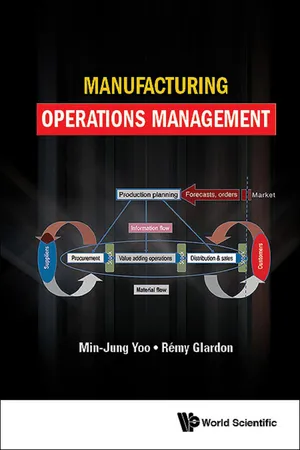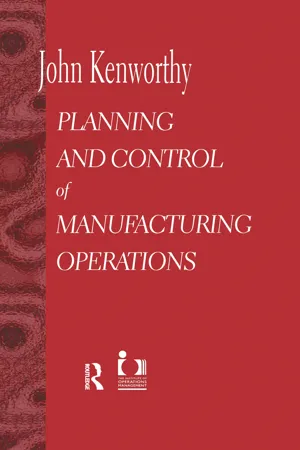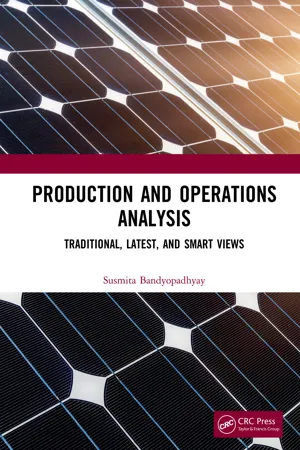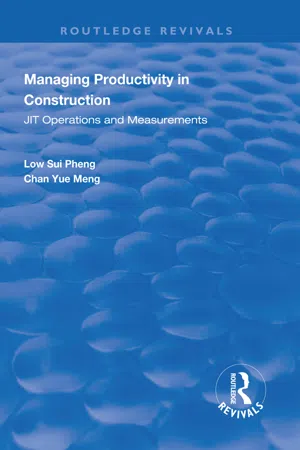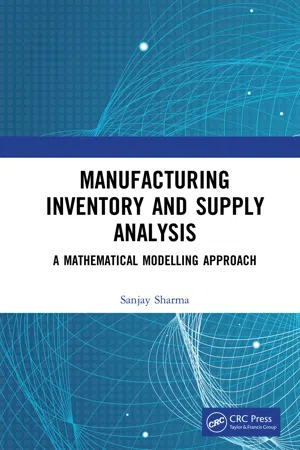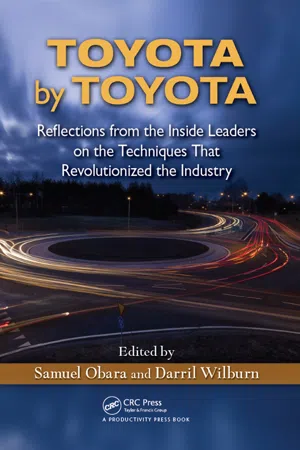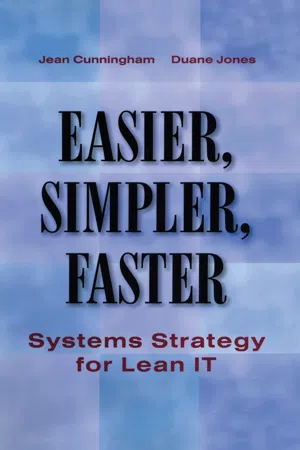Business
Just-In-Time Inventory Management
Just-In-Time (JIT) inventory management is a strategy used to minimize inventory holding costs by receiving goods only as they are needed in the production process. This approach aims to reduce waste, improve efficiency, and lower storage expenses. By synchronizing production with demand, companies can enhance their responsiveness to market fluctuations and streamline their operations.
Written by Perlego with AI-assistance
Related key terms
Related key terms
1 of 4
Related key terms
1 of 3
11 Key excerpts on "Just-In-Time Inventory Management"
- eBook - ePub
- Min-Jung Yoo, Rémy Glardon(Authors)
- 2018(Publication Date)
- WSPC (EUROPE)(Publisher)
•Increase of service quality (i.e. reliability of delivery).These trends are primarily due to the global market and competition that companies have to deal with, while always putting forward their distinguishing advantages. The consequences of this business evolution on production & operations management are that:•Rationalisation methods adapted to high volumes (heavy automation) become inappropriate; •Planning methods based on medium term forecasts become inapplicable. Therefore, it is preferable that management method and tools are adapted to such a situation, in particular: •Improve the delivery flexibility without increasing tied-up capital;•Satisfy market demand as quickly as possible, i.e. Just-In-Time;•Reduce the costs, particularly the costs that do not contribute to adding value, i.e. the hidden factory.This is what the Just-in-Time approach tries to do. Several definitions of Just-in-Time, JIT, can be found in the abundant literature on the subject. Among many definitions, within the scope of this book, we define it as “A production and logistics strategy based on an efficient management of material and information flows, with the purpose of responding to market requirements with maximum efficiency”.The most well-known principle of JIT concerns produce only what will be sold, at the right moment, with the required quality and in exact quantity. It is noted that JIT can be seen and has been used as a: •Global production philosophy; •Strategy for production and logistics organisation; •Management method; •Group of management, planning and control techniques.As stated above, JIT calls for simplification and transparency. It promotes also continuous improvement and the resolution of inefficiencies and malfunctioning instead of creating buffers in order to cover them. This is an important philosophical element, which often corresponds to a cultural attitude and a major change.JIT advocates a permanent fight against any activity and cost that does not add value for the customer. Subsequently, it calls for the elimination, or reducing as much as possible all administrative tasks, centralised hierarchical controls. Instead of such inefficiencies, it looks for simplification and the delegation of responsibility to the shop-floor. This ballast of non-value-adding activities is sometimes called the hidden factory - eBook - ePub
- Geoffrey Lancaster, Lester Massingham(Authors)
- 2017(Publication Date)
- Routledge(Publisher)
The third development was the transition to the flexible firm. This phase involved a distinct change in the production process, with flow production and small batch runs of a wide assortment of products operated by teams of multi-skilled employees. Increasingly, companies have turned to this new form of flexible lean production based on flexible cells and working arrangements. Accompanying this growth of lean manufacturing has been the introduction of Just in Time (JIT) systems of manufacturing and purchasing. First used extensively in Japan, JIT took time to make inroads in the West. As the term implies, in the context of manufacturing and purchasing, JIT is based on a company securing supplies of raw materials and components needed for the manufacturing process at the precise point in time when they are required to enter this process. Dion et al. 10 defined JIT as: An inventory control system which delivers input to its production or distribution site only at the rate and time it is needed. Thus it reduces inventories whether it is used within the firm or as a mechanism regulating the flow of products between adjacent firms in the distribution system channel. The JIT approach contrasts with the more conventional approach to stockholding delivery and manufacturing which was based essentially on the Just in Case principle. Oliver 11 provides a comparison between Just in Case and Just in Time approaches in Table 6.1. Implications of the introduction of JIT/lean manufacturing systems for the marketer have been wide reaching. In the context of logistics, the successful servicing of customers using a JIT system implies a fundamental alteration of the design and operation of the logistical process. Success requires precise synchronization from supplier right through to production units to retailers to consumers - eBook - ePub
- John Kenworthy(Author)
- 2013(Publication Date)
- Routledge(Publisher)
11Just in Time and Continuous Improvement
11.1 What is Just in Time?The concept of Just in Time manufacturing or JIT has received a lot of publicity since the mid-1980s, much of it based on some significant misunderstandings. Visitors to Japan in the early 1980s came back with stories of how suppliers to Toyota made deliveries several times a day and took parts directly to the production line such that they arrived just before they were needed. Just in Time delivery was seen as the key to the process. Investment in stock was minimised and only minimal storage space was taken up by components alongside the production line.However, attempts to emulate the Japanese and implement Just in Time deliveries in the west all too often resulted in Just Too Late or JTL. In placing the emphasis on timeliness, the western observers had missed the point that Toyota had devoted a vast amount of effort to improving the quality, reliability and effectiveness of their products and processes so as to make Just in Time delivery of components feasible. Manufacturing does not become efficient and effective because deliveries are made Just in Time. Just in Time deliveries become possible when manufacturing becomes efficient, effective and reliable.In companies which have not had a specific improvement programme, adopting a Just in Time approach would put production at risk of stoppage for many reasons. The most easily identified include equipment breakdown at the component manufacturing stage, transport delays if, as is possible, the supplier is several hundred miles away, quality problems, unreliable processes and inadequately co-ordinated design changes. Less obviously recognisable risks result from long lead times, long set-up times and large order sizes. The reasons why the last three parameters are incompatible with Just in Time will be discussed later in this chapter. - eBook - ePub
Production and Operations Analysis
Traditional, Latest, and Smart Views
- Susmita Bandyopadhyay(Author)
- 2019(Publication Date)
- CRC Press(Publisher)
Section 10.2.2 . The various implementation measures as discussed are red tagging, use of signboards, outlining, use of Andon, use of Kanban, use of buzzers.Till now, a significant number of aspects related to the JIT manufacturing concept have been discussed. The next section now discusses the various important aspects of JIT logistics, in brief.10.7.1 Just-in-Time Logistics
The American Council of Logistics Management defines logistics as “the process of planning, implementing and controlling the efficient, cost effective flow and storage of raw materials, in-process inventory, finished goods, and related information from point of origin to point of consumption for the purpose of conforming to customers’ requirements.” Philip Kotler defines logistics as “planning, implementing, and controlling the physical flows of materials and finished goods from point of origin to point of use to meet the customer’s need at a profit.” The basic objectives of logistics activity can be delineated through the following points.• Minimization of inventory• Minimization of costs related to logistics• Reliable and consistent delivery of performance• Minimize the damage to the products• Quicker and faster response to the customersHowever, from the point of view of JIT, the goal of logistic is to deliver to customer, the right product in right condition in right quantity, to the right customer at the right place at the right time, at the right price - eBook - ePub
- Kee-hung Lai, T.C.E. Cheng(Authors)
- 2016(Publication Date)
- Routledge(Publisher)
Another hybrid involves having temporary capacity to meet the needs of peak demand. Most companies experience a base level of demand over the course of the year. This base level of demand can be accommodated in a lean manner, using the company’s own resources to employ smooth production principles to maintain highly efficient operations. However, when demand spikes over the course of peak seasons or heavy promotion periods, outside capacity is procured to meet the heightened demands of these distinct windows. The procurement of outside capacity for coverage in these situations is viewed as the agile component of this hybrid approach. Many companies engage leagile supply, manufacturing, and logistics to support seasonal demand. The third hybrid approach is termed postponement, which is about delaying the final form of the product until an order is received from customers dictating the quantity and qualities of the goods demanded (Feitzinger and Lee 1997). This approach works best when goods can be developed from common materials into a near-finished state with final touches to the product providing for a diverse assortment that accommodates distinct customer needs. The premise calls for lean operations in the production of generic, semi-finished products, and agile accommodation in the customization process. It is on the basis of accommodating diverse needs efficiently that one may refer to such an approach as ‘mass customization’ (Feitzinger and Lee 1997).INVENTORY MANAGEMENT TOOLS
The ideas behind JIT logistics are to connect buyers and suppliers in the logistics activities throughout an entire supply chain to jointly bring about total supply chain cost reduction and service improvement. This is accomplished through ensuring continuous process improvements, eliminating NVA practices, matching inventory flows with consumption and linking information flows to inventory flows. Anything that disrupts the logistical flows of goods in the supply chain creates systemic costs in terms of time and inventory. There exist several useful management tools that can aid management to better manage their inventories. These include:Kanban
This is a restocking system that has evolved through the refinement of the production system at Toyota Motor Corporation. This management tool for JIT logistics helps to control the delivery of the necessary quantities and timing of the various parts throughout the operations among suppliers with which the focal firm interacts. Kanban is an information system or card system used to help ‘pull’ the necessary parts into each operation where customer demand creates the initial pull of the system. Kanban is analogous to a travel card, floating order card or travelling requisition as utilized in the purchasing function (Chase et al. 2006). The movement of materials through each of the activities is comparable to the movement of a water bucket passing in an old-fashioned fire-brigade. To provide the system responsiveness and product availability necessary in an increasingly unpredictable environment, the total system must use Kanban throughout the pipeline of materials flow. Implementation of Kanban piecemeal, starting with customer demand and moving upstream in the pipeline of material flow provides the tying mechanism for the continuous transmission of information in processing and across all activities. This allows for real-time decision making. - eBook - ePub
Managing Productivity in Construction
JIT Operations and Measurements
- Low Sui Pheng, Chan Yue Meng(Authors)
- 2018(Publication Date)
- Routledge(Publisher)
Source: O’Grady, P.J. (1988), Putting the Just-In-Time philosophy into practice: A strategy for production managers, Kogan Page LtdThe vertical scale in Figure 2.7 has been exaggerated to show the effect but it can easily be seen that the approach works by the gradual accumulation of a series of small increases in efficiency. When enough of these small increases are combined, the result is major increase in efficiency. This has been the experience of the Toyota production line.In designing a JIT system, the aim is therefore not only to lower work in progress levels and manufacturing lead times but also to identify problems as soon as they occurred so that immediate remedial action could be taken. However, in order to identify a problem properly, a manufacturing process should be prepared to pay the price in terms of some short-term setbacks. In the hypothetical example given earlier, the entire Toyota line was stopped because of a fault in a single centre stoplight; this is something many traditional approaches which take a short-term view would consider unthinkable. In the long term, however, it is often only by ensuring that even a small problem has a major impact that attention will be concentrated upon it. The serious implementation of JIT would thus require two things:- To set up “pull” ∕ “kanban” mechanisms so that problems can be easily identified.
- To be prepared for a short-term drop in efficiency to gain a long-term advantage.
Uninterrupted workflow
In JIT, the master schedule (or final assembly schedule) is planned for one to three months into the future to allow work centres and vendors to plan their respective work schedules. Within the current month, the master schedule is levelled on a daily basis. In other words, the same quantity of each product is produced each day for the entire month. Furthermore, small lots (preferably lot size equal 1) are scheduled in the master schedule to provide a uniform load on the plant and vendors during each day. - Turan Paksoy, Muhammet Deveci, Turan Paksoy, Muhammet Deveci(Authors)
- 2023(Publication Date)
- CRC Press(Publisher)
Deuse et al. 2020). Just-in-time (JIT) JIT is an operating concept that aims to eliminate waste and make the process more efficient. It was developed in the 1950s and achieved significant success at Toyota (Canel et al. 2000). Total productive maintenance (TPM) TPM is a manufacturing approach that aims to maximize the effective use of equipment by means of the participation and motivation of all workers (Cua et al. 2001). Kanban The Japanese word kanban means “card” or “sign”, and in lean practices, kanban refers to control cards used in a pull system. Kanban is a visual control system that aims to eliminate waste such as overproduction, increase flexibility and agility in response to volatile customer demand, and reduce cost by eliminating waste (Arbulu et al. 2003). Daily management system (DM)(T-kart) DM is a continuous process that allows people to visualize whether the work is done in the right way and whether the performance is good enough or not to achieve the expected business performance (Ferro and Gouveia 2015). One-piece flow One-piece flow refers to moving one part at a time between sequential operations in a production process. One-piece flow production system emphasizes factors such as sequencing, setup time, and make-to-order policy during production scheduling (Sundar et al. 2014). Cellular manufacturing Cellular manufacturing refers to the physical division of a facility’s machinery into production cells, each aiming to produce a family of parts (Drolet- eBook - ePub
Manufacturing Inventory and Supply Analysis
A Mathematical Modelling Approach
- Sanjay Sharma(Author)
- 2021(Publication Date)
- CRC Press(Publisher)
3
Batch Size Relevance for Just-in-Time (JIT)
DOI: 10.1201/9781003213994-3In the just-in-time (JIT) philosophy, the emphasis is on keeping inventories as small as possible. Consider a company engaged in manufacturing of a product which requires a certain input item. The management is interested in procuring the minimum stock of the input item. A model needs to be developed for this purpose, including production of finished item and replenishment of the input item.3.1 PRODUCTION WITH REPLENISHMENT OF INPUT ITEM
For a successful practical implementation of the JIT concept, there has to be a strategic alliance between the manufacturing organization and the supplier of the input item. Therefore, it is assumed that rigorous inspection procedures are adopted at the supplier’s end and no defective input item would be supplied to the manufacturing company. Production of end item, along with replenishment of input item, is shown in Figure 3.1 .Let:FIGURE 3.1Production of end item, along with replenishment of the input item.- Annual demand for end item = R
- Demand rate of end item per period = r
- Production rate/period = p
- Proportion of nondefective end items in a lot = y
- Production lot size = Q
- Units of the input item required per unit of the end product = n
- Replenishmentrate of the input item = d
- Number of orders for procurement of the input item in a production cycle = k
- Fixed ordering cost for the input item = A
- Fixed production setup cost for the end product = C
- Production cost per unit (including value addition) = P
- Annual inventory carrying cost fraction = F
- Purchase cost per unit of the input item = G
Total annual cost concerning the end product was obtained in Section 2.2 , as expressed by Equation 2.26, i.e.,(3.1)=+( y p − r ) P F Q2 p+R Cy QP PyReferring to Figure 3.1 , cycle time is yQ/r and production takes place for time Q/p in the C.T. Input item procurement is during time Q/p only. Fraction of cycle time during which input item inventory exists ==( Q / p )( y Q / r )ry p - eBook - ePub
Toyota by Toyota
Reflections from the Inside Leaders on the Techniques That Revolutionized the Industry
- Samuel Obara, Darril Wilburn(Authors)
- 2012(Publication Date)
- Productivity Press(Publisher)
I started my job as a process engineer. I was responsible for defining the stages of heat treatment between the steps of aluminum sheets lamination, and I realized this company had a method of work that made me curious; work teams were tasked to improve devices, processes, tools, etc. The teams were composed of people from different areas and responsibilities with a common goal of continuous improvement; each one had a leader responsible for the team, including organizing meetings, materials, schedules, classrooms, etc. The activities of each of the members were discussed according to the tasks and goals set in previous meetings, there was visual control of the activities of each group member, and they were very strict with the dates of beginning and end of each task.The methodology used in this company at that time left a very good impression. After researching more, I realized it was deeper than I imagined. It was aimed not only at continuous improvement but a whole philosophy of implementation of a production system; it was the culture based on the improvement of man with the obsession to always be improving the processes to pursue waste elimination.The vision of this company for continuous improvement in the elimination of waste radically changed the way I used to think and act as a process engineer.Years later, while working at Toyota, I learned more about the culture and principles this company was implementing; it was clear they already used many of these principles of Toyota Production System (TPS), in particular, Kaizen, or continuous improvement.JUST-IN-TIME
Introduction
The concept of Just-In-Time (JIT) at Toyota was established after years of continuous improvement within the production processes, aiming to manufacture the vehicles demanded by customers in a fast and efficient manner, making the delivery time to be as short as possible.JIT was not simply an inventory reduction, or the solution to bad management. It focuses attention on how the skills and knowledge of employees can best be used to improve productivity, safety, and quality. It is also about how to engage and commit all levels of the organization to aim toward the same objective. - Roberto Villaseñor Roldán(Author)
- 2022(Publication Date)
Chapter 5. Inventory Managment and its Effect on the Supply Chain
IntroductionT his chapter continues exploring dynamic models that represent situations that industrial engineers typically experience and manage in organizational settings; in particular, supply chain and reverse logistics dynamic models. This book considers supply chain management as an important subject matter because organizations, regardless of their size and main location, belong to one or several supply chains Supply chains reach all economic levels and they operate in formal and informal economies.Although supply chains represent a fundamental structure (or mental model) in local and global economies, their behavior is far from being well understood (Sterman, 1989). As a result, many organizations experience oscillations which go from sudden shortages and backlog to increasing excess in their inventories. Mismanagement and lack of understanding of the supply chain has a negative effect on workforce, investment, customer satisfaction, among others. The hardest effect of inventory mismanagement is probably felt by the workforce: On the one hand, when inventories reach a high level without appropriate sales, employees are made redundant and unemployment climbs; on the other hand, when inventories decrease down to a low level creating shortages, employees are hired to increase the workforce level. The result is a harmful feeling of uncertainty among the workforce.From a Just in Time (JIT) perspective or from a Lean Thinking perspective, excess of inventories do not add value neither to customers nor to organizations. Inventories generate costs and they may cover up quality issues. Therefore, mismanagement of inventory levels is often considered waste (Wisner and Stanley, 2008) or muda (Womak and Jones). As a result, management of inventory levels has an effect on the management of a supply chain; a subject matter that is critical in contemporary organizations.- eBook - ePub
Easier, Simpler, Faster
Systems Strategy for Lean IT
- Jean Cunningham, Duane Jones(Authors)
- 2020(Publication Date)
- Productivity Press(Publisher)
CHAPTER 5Kanban: Reducing Inventory and Managing Pull with Suppliers
C ONTINUOUS IMPROVEMENT IS A PHILOSOPHY that naturally extends to delivering your product. At Lantech, the various kaizen teams are constantly reviewing how to improve the quality and cost of manufacturing, as well as how to deliver value to the customer. That means we change our product on a regular basis, whether it is replacing Part A with Part B, improving Part A, or combining Part A and Part B into a single component. Part of the improvement process includes determining the cost of the change. One aspect of that calculation is the impact of the change on the inventory on hand, and thus, one continuous improvement focus is reducing inventory on hand.One important goal for a lean manufacturing company is the mandatory effort to reduce inventory. To approach the goal of one-piece flow you need to turn inventory rapidly through frequent deliveries of small lot sizes. Lantech uses JIT education as part of each kaizen event, and then follows up with additional courses to help employees accomplish this. For the first few years, learning about lean was also part of our new employee orientation. After implementing our initial cell via kaizen, we continued to use kaizen events and tools such as 5S and total productive maintenance (TPM) to improve those areas with the greatest barriers to improvement. We also continued to reinforce lean thinking.This chapter reviews some of the major operational improvements and savings you will gain by using kanban externally with your suppliers to manage your pull system with less inventory. Many readers may be familiar with kanban, which may already be part of their company’s operations. Our goal here is to discuss the specific benefits of kanban, working with your suppliers to support it, aligning your IS accordingly, and the benefits of managing less inventory. Because kanban is such an important tool to lean manufacturing, it is important to understand that your kanban efforts are more likely to succeed if you have already some lean elements (for example, TPM and JIT training) in your manufacturing process. Readers who are not familiar with implementing kanban in a lean environment might want to consult one or more books on the subject.1
Index pages curate the most relevant extracts from our library of academic textbooks. They’ve been created using an in-house natural language model (NLM), each adding context and meaning to key research topics.
Explore more topic indexes
Explore more topic indexes
1 of 6
Explore more topic indexes
1 of 4
